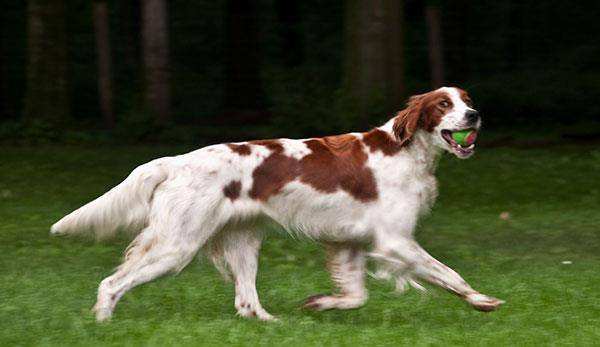Irish Setter
IUCN
LCBasic Information
Scientific classification
- name:Irish Setter
- Scientific Name:
- Outline:Carnivora
- Family:Canidae
Vital signs
- length:64-69cm
- Weight:27-32kg
- lifetime:12-13year
Feature
Lively and positive, with a gentle personality, suitable for accompanying children.
Distribution and Habitat
The Irish Setter, whose earliest ancestors were found on the island of Emmelden, where it originated.
Appearance
The thin ears are set low, loosely folded and close to the head. The oval eyes show a submissive look. The nose is black or ochre. The upper lip is thin and well attached. The forelegs are well-coated with straight and long hair, and the forelegs are straight and powerful. The feet are small with hard and compact toes. The tail is set down and carried horizontally or drooping.
The hair on the head and front legs is short and fine. The hair on all other parts is of moderate length and flat. The frills on the ears are long and silky, and the frills on the front legs and back of the thighs are long and fine. There is frills on the abdomen and thorax extending to the chest, and the frills on the tail are of medium length and gradually decrease. The entire coat and frills are straight, without curls or ripples. The Irish Setter may be trimmed when showing to emphasize the head. The neck is slender and clean. The top 1/3 of the ears and the throat close to the breastbone should be trimmed
Details
Irish Setter is a general term for Irish Red Setter and Irish Red and White Setter. Among them, it is generally believed that Irish Setter refers to Irish Red Setter. In the United States, long-distance bus routes are marked by greyhounds, while Ireland once used Irish Setter as a mascot and logo, which was officially interpreted as conveying "friendly, reliable and fast travel services."

The earliest ancestors of the Irish Setter in its place of origin, Emmelden Island, rarely had a single coat color. Most of them were red and white, and white was often more than red. Even now, many individuals hybridized with the Irish Water Spaniel are colored. However, in the United States, dogs with all-red coats or red with a small amount of imperceptible white traces are considered the only typical breed of Irish Setter.
The first Irish Setters introduced to the United States were used for hunting. Although the local skittish grouse, quail and prairie pheasants were unfamiliar to them, they were able to adapt quickly to their prey. In 1875, "Irke" was introduced as the first Irish Setter to win honors for himself and his descendants in the United States. He not only achieved amazing success in the exhibition booth, but also became a shooting hound after being fully trained.
The Irish Setter originated from Ireland. Working dogs, they can cooperate with hunters in difficult conditions. As an excellent bird hunting dog, it can search for birds. When it smells the traces of prey and finds prey, it will take a motionless posture like a pointer hound, squatting on the ground or showing the position with its nose, so it is also called the hunter's "other gun".
The Irish Setter is a fast hunter in the wild. In the family, he is a sweet-tempered and easy-to-train companion suitable for children, but he matures slowly. He is playful and naughty, suitable for people with a heart to raise.
Protect wild animals and eliminate game.
Maintaining ecological balance is everyone's responsibility!








